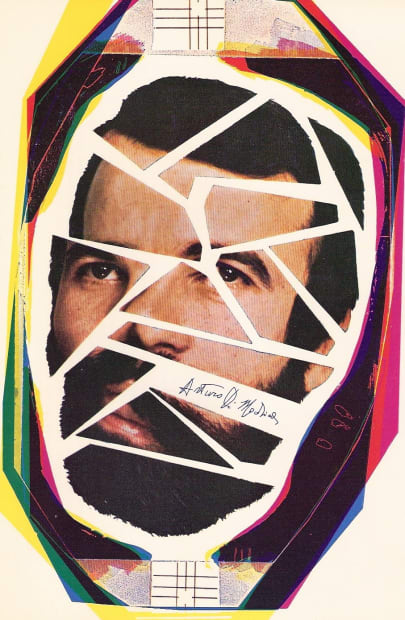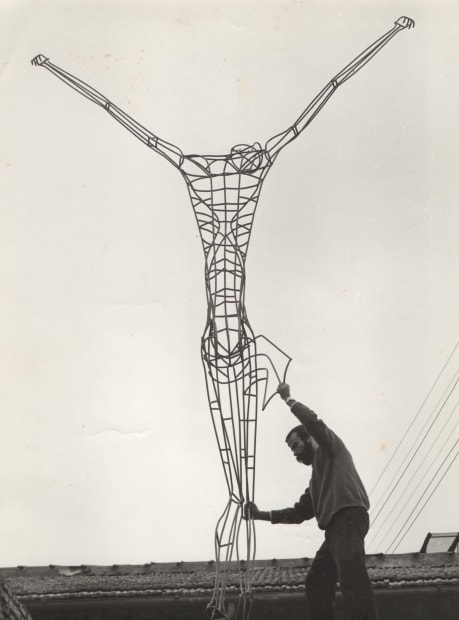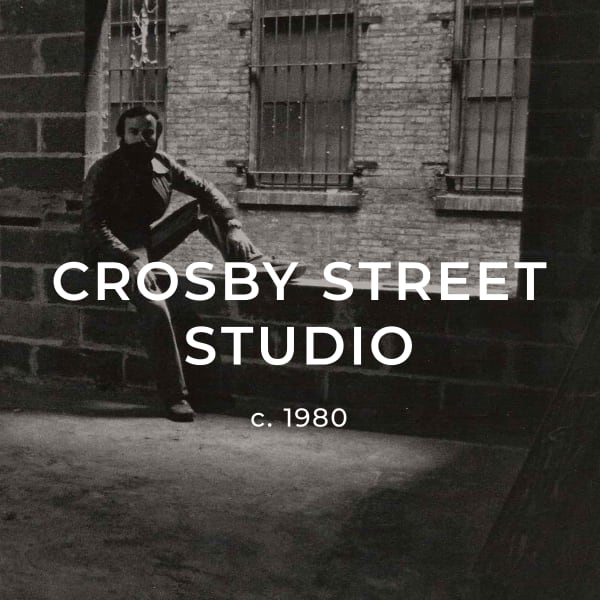-
 1968: Villa Medici exhibition invitation
1968: Villa Medici exhibition invitation -
"I had to escape in secret because my father would have never approved of my choice. At 18, I ran away on a train destined for Florence to pursue the life of an artist"
- Arturo Di Modica
Arturo was both willful and inquisitive as a child, disinclined to stick to the rules, always ready to drop what he was supposed to be doing and tear off in some promising direction. Even as a child his preferred distractions were objects to delight the eye – as when he would plunge aside from the short path between his home and school to see if he could dig up a Roman pot or other relict, rather than sit at his desk and work at his ABCs or sums. In 2017 he told an interviewer, Giovanna Caggegi, that as a child he had also liked to hang out at the craftsmen’s workshops and watch them weaving baskets and carving wooden carts. “I asked my father if I could go to one of these as an apprentice,” he says. He began making small clay models when still young, but no photographs survive of these, nor indeed of the young Arturo Di Modica at that time.
-
Sicily
1941-1960 -
The countryside around Vittoria was a huge presence in Di Modica’s teenage years, remains so in his imagination today and plays an important part in his plans for his future work. The city sits on a plain between two rivers: the Ippari and the Dirillo. This being Sicily, the past is barely past, and the Ippari valley boasts traces of a Bronze Age settlement, while the ruins of the ancient Greek city of Kamarina are at the river mouth. Di Modica tells how it was his childhood dream to make the clogged Ippari a trafficked waterway once again and this is the inspiration for Wild Horses, the hugely ambitious project that he is still working on today at 78 years of age.
It is impossible to miss signs of the influence of local geography upon some of Di Modica’s very early oil paintings. The untitled canvas with Catalogue No. 32 is a case in point. In a still life primarily painted with sober ochre tones, a wall is constructed from big stones, a vase and various furnishings. Archaic forms are also clearly referenced, as, of course, is the Sicilian landscape. You also sense the influence of many Italian masters of the period, not only Carlo Carrà and Massimo Campigli, but also Giorgio Morandi, whose obsessive experimentation was carried out as a highly particularized genre of artistic research in the context of the so-called ‘return to order’.
Di Modica paid close attention to the art-world tensions between close realism and an openness towards abstraction, which was a feature of 1950s Italy. Clearly he was inclined to the latter. Consider, for example, the untitled work Catalogue No. 30 where an absolute whiteness contrasts with the intense warmth of red and yellow; both spread with wide and irregular brushstrokes. You can sense the presence of a landscape, but the shapes lose definition because of the force of the color that ignites the canvas, just as a torrid summer sky will seem to set a Sicilian landscape on fire.
-
-

Untitled 32 (c.1958)
-

Untitled 30 (c. 1959)
-
-
Florence
1960 -
 c.1966 Di Modica first sculpture (later destroyed), Florence
c.1966 Di Modica first sculpture (later destroyed), Florence -
Much of Di Modica’s life at the Academy of Fine Arts was, of course, focused on work: the mastery of his craft, but there was also constant interplay with the cadre of lecturers there, men such as Afro Basaldella, Oscar Gallo and Quinto Martini, and the teacher of painting, Gastone Breddo. The large student body at the Free School of the Nude included a great many foreign students, especially Americans, so the young Sicilian was able to satisfy his growing curiosity about their huge, enticing native land. He also got to know students enrolled in the Faculty of Architecture and was able to put some of the manual skills he had developed in the garage to use in constructing scale models for them. And he was showing his own work, both in Italy and abroad. Recognition that came his way included the Brasilia Prize in 1960 and, just two years later, the Young Artists Prize in Rome.
Di Modica told the writer, Nello Correale, just how he launched out as an artist. His professors in Florence could see that he had learned what the academy had to offer, that it was high time for him to sever ties, relinquish academic commitments and set out on his own. The conversations were profoundly moving. Here is his new beginning in his own words:
“Alfio Rapisardi, Angelo Vadalà and I formed a highly eclectic and very noticeable trio, with the Piazza della Signoria as our workshop and showroom. With my sculptures and nude paintings I had already bothered the artistic environment of Florence. I was too eccentric for that time, so much so that my teachers suggested I go to America.”
-
"Henry Moore and I were working alongside each other in the same Carrara marble studio as he prepared for his Florence show. He would call me the young Michelangelo"
- Arturo Di Modica
The threesome, Rapisardi, Vadalà and Di Modica, shared ideas and discussions, hard times and eventual success. They painted and sculpted non-stop, putting together their individual art languages, testing journeys, full of trials and failures and always “living day-to-day”. Let us imagine them in their space, shoulder to shoulder with the artisans, surrounded by their work, sculptural and pictorial forms. Arturo Di Modica had his own Florentine studio for seven years, building the foundry in which he would melt a hundred kilos of bronze at a time. During that time he learned how to deal with the individuals an active artist attracts. That is where the artist grew into what he became. In 1964, using the pseudonym ‘Renuardi’, Di Modica took part in a collective exhibition in Vittoria with Arturo Barbante, Giovanni Rosario Biscari, Francesco Cesareo, Turi Cucchia, Giovanni Di Modica, Pietro Palma and Alfredo Parisi. He presented a work called L’albero degli incubi (The Tree of Nightmares), which depicted a trunk with mixed figures and abstract forms. During these years the forms in his pieces stretch, break up and deform, as in the figures in both the foreground and background of the work in Catalogue No. 8. -
Florence Floods
1966 -
 c. 1969: Arturo Di Modica working on his Crucixiftion of Christ
c. 1969: Arturo Di Modica working on his Crucixiftion of Christ -
"With my sculptures and nude paintings I had already bothered the artistic environment of Florence. I was too eccentric for that time, so much that my teachers suggested me to go to America"
- Arturo Di Modica
At the beginning of the 1970s, the Italian political climate was becoming darker, contentious, threatening. The magic of Florence, his adopted city, was weakening for Arturo Di Modica. There was simply too heavy a weight of history for the artist known as the Disruptor to evolve his own code, hack his own path, create his own book of rules. Where to go? No contest. His friend Vidala had departed for the United States in 1970. America it must be.
-
1968: Villa Medici Exhibition, Florence














